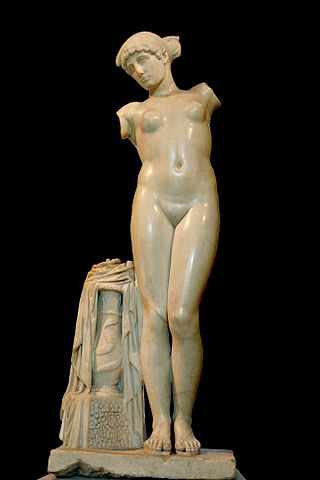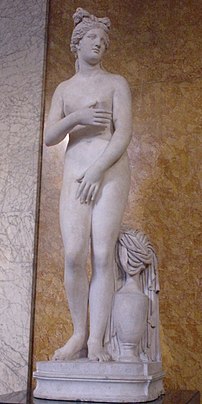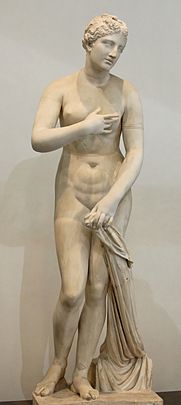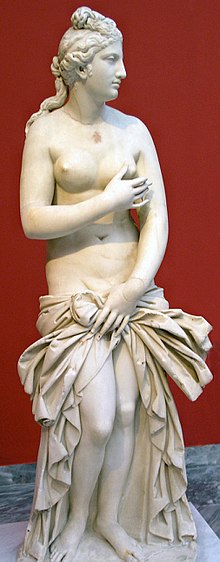
The Venus de Milo or Aphrodite of Melos is an ancient Greek sculpture that was created during the Hellenistic period. It is one of the most famous works of ancient Greek sculpture, having been prominently displayed at the Louvre Museum since shortly after the statue was rediscovered on the island of Milos, Greece, in 1820.

Praxiteles of Athens, the son of Cephisodotus the Elder, was the most renowned of the Attica sculptors of the 4th century BC. He was the first to sculpt the nude female form in a life-size statue. While no indubitably attributable sculpture by Praxiteles is extant, numerous copies of his works have survived; several authors, including Pliny the Elder, wrote of his works; and coins engraved with silhouettes of his various famous statuary types from the period still exist.

The Farnese Hercules is an ancient statue of Hercules, probably an enlarged copy made in the early third century AD and signed by Glykon, who is otherwise unknown; he was an Athenian but he may have worked in Rome. Like many other Ancient Roman sculptures it is a copy or version of a much older Greek original that was well known, in this case a bronze by Lysippos that would have been made in the fourth century BC. This original survived for over 1500 years until it was melted down by Crusaders in 1205 during the Sack of Constantinople. The enlarged copy was made for the Baths of Caracalla in Rome, where the statue was recovered in 1546, and is now in the Museo Archeologico Nazionale in Naples. The heroically-scaled Hercules is one of the most famous sculptures of antiquity, and has fixed the image of the mythic hero in the European imagination.

The Discobolus by Myron is an ancient Greek sculpture completed at the start of the Classical period in around 460–450 BC that depicts an ancient Greek athlete throwing a discus. Its Greek original in bronze lost, the work is known through numerous Roman copies, both full-scale ones in marble, which is cheaper than bronze, such as the Palombara Discobolus, the first to be recovered, and smaller scaled versions in bronze.

The Capitoline Museums are a group of art and archaeological museums in Piazza del Campidoglio, on top of the Capitoline Hill in Rome, Italy. The historic seats of the museums are Palazzo dei Conservatori and Palazzo Nuovo, facing on the central trapezoidal piazza in a plan conceived by Michelangelo in 1536 and executed over a period of more than 400 years.

The Aphrodite of Knidos was an Ancient Greek sculpture of the goddess Aphrodite created by Praxiteles of Athens around the 4th century BC. It was one of the first life-sized representations of the nude female form in Greek history, displaying an alternative idea to male heroic nudity. Praxiteles' Aphrodite was shown nude, reaching for a bath towel while covering her pubis, which, in turn leaves her breasts exposed. Up until this point, Greek sculpture had been dominated by male nude figures. The original Greek sculpture is no longer in existence; however, many Roman copies survive of this influential work of art. Variants of the Venus Pudica are the Venus de' Medici and the Capitoline Venus.

San Gregorio Magno al Celio, also known as San Gregorio al Celio or simply San Gregorio, is a church in Rome, Italy, which is part of a monastery of monks of the Camaldolese branch of the Benedictine Order. On 10 March 2012, the 1,000th anniversary of the founding of the Camaldolese in 1012 was celebrated here at a Vespers service attended by Anglican and Catholic prelates and jointly led by Pope Benedict XVI and Rowan Williams, Archbishop of Canterbury.

The Venus de' Medici or Medici Venus is a 1.53 m tall Hellenistic marble sculpture depicting the Greek goddess of love Aphrodite. It is a 1st-century BC marble copy, perhaps made in Athens, of a bronze original Greek sculpture, following the type of the Aphrodite of Knidos, which would have been made by a sculptor in the immediate Praxitelean tradition, perhaps at the end of the century. It has become one of the navigation points by which the progress of the Western classical tradition is traced, the references to it outline the changes of taste and the process of classical scholarship. It is housed in the Uffizi Gallery, Florence, Italy.

The Colonna Venus is a Roman marble copy of the lost Aphrodite of Cnidus sculpture by Praxiteles, conserved in the Museo Pio-Clementino as a part of the Vatican Museums' collections. It is now the best-known and perhaps most faithful Roman copy of Praxiteles's original.
The Barberini Venus, Jenkins Venus or Weddell Venus is a sculpture and copy of the Aphrodite of Cnidus, along the lines of the Venus de Medici. Its torso is a Hadrianic copy in Parian marble of the same type as the Venus de' Medici, with 18th-century restorations.

Borghese Venus, 2nd century CE Roman marble copy of the Aphrodite of Cnidus. Once in the Borghese collection, it now resides in the Louvre Museum thanks to its purchase by Napoleon. The accompanying Cupid and dolphin are both classical attributes of Venus but are probably the addition of the Roman copyist. Its accession number is MR 369.

The Esquiline Venus, depicting the goddess Venus, is a smaller-than-life-size Roman nude marble sculpture of a female in sandals and a diadem headdress. It is widely viewed as a 1st-century AD Roman copy of a Greek original from the 1st century BC. It is also a possible depiction of the Ptolemaic ruler Cleopatra VII.

The Crouching Venus is a Hellenistic model of Venus surprised at her bath. Venus crouches with her right knee close to the ground, turns her head to the right and, in most versions, reaches her right arm over to her left shoulder to cover her breasts. To judge by the number of copies that have been excavated on Roman sites in Italy and France, this variant on Venus seems to have been popular.

The Aphrodite of Menophantos is a Roman marble statue of the goddess Venus. Its design takes the form of "Venus Pudica", based on another statue, the Capitoline Venus. It was found at the Camaldolese monastery of San Gregorio al Celio in Rome, and is now in the Palazzo Massimo alle Terme, Rome. It bears the signature of Menophantos, a Greek sculptor, apparently of the 1st century BCE, of whom nothing more is known.

The Venus of Arles is a 1.94-metre-high (6.4 ft) sculpture of Venus at the Musée du Louvre. It is in Hymettus marble and dates to the end of the 1st century BC.

The Apollino or Medici Apollo is a Roman copy of a Hellenistic sculpture of the adolescent god Apollo of the Apollo Lykeios type. It is now in the Uffizi, Florence.

The Resting Satyr or Leaning Satyr, also known as the Satyr anapauomenos is a statue type generally attributed to the ancient Greek sculptor Praxiteles. Some 115 examples of the type are known, of which the best known is in the Capitoline Museums.

The marble Cupid and Psyche conserved in the Capitoline Museums, Rome, is a 1st or 2nd century Roman copy of a late Hellenistic period original. It was given to the nascent Capitoline Museums by Pope Benedict XIV in 1749, shortly after its discovery. Its graceful balance and sentimental appearance made it a favourite among the neoclassical generations of artists and visitors, and it was copied in many materials from bronze to biscuit porcelain. Antonio Canova consciously set out to outdo the Antique original with his own Cupid and Psyche of 1808

The Venus Callipyge, also known as the Aphrodite Kallipygos or the Callipygian Venus, all literally meaning "Venus of the beautiful buttocks", is an Ancient Roman marble statue, thought to be a copy of an older Greek original. In an example of anasyrma, it depicts a partially draped woman, raising her light peplos to uncover her hips and buttocks, and looking back and down over her shoulder, perhaps to evaluate them. The subject is conventionally identified as Venus (Aphrodite), though it may equally be a portrait of a mortal woman.

The statue of the Aphrodite of Syracuse in the National Archaeological Museum of Athens (NAMA) with the inventory number 3524 is dated to the second century AD.























